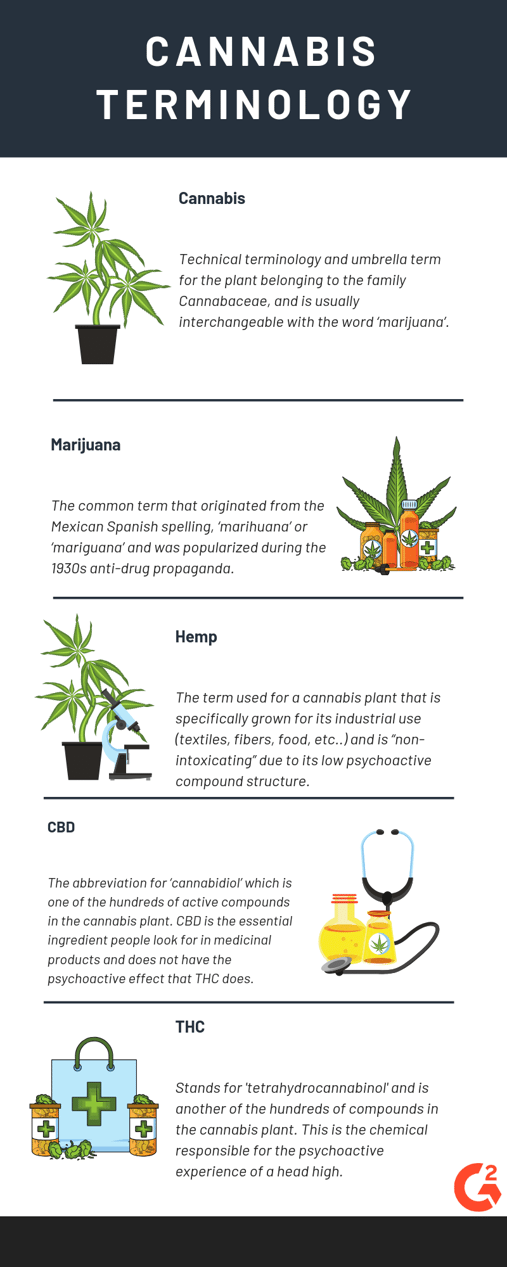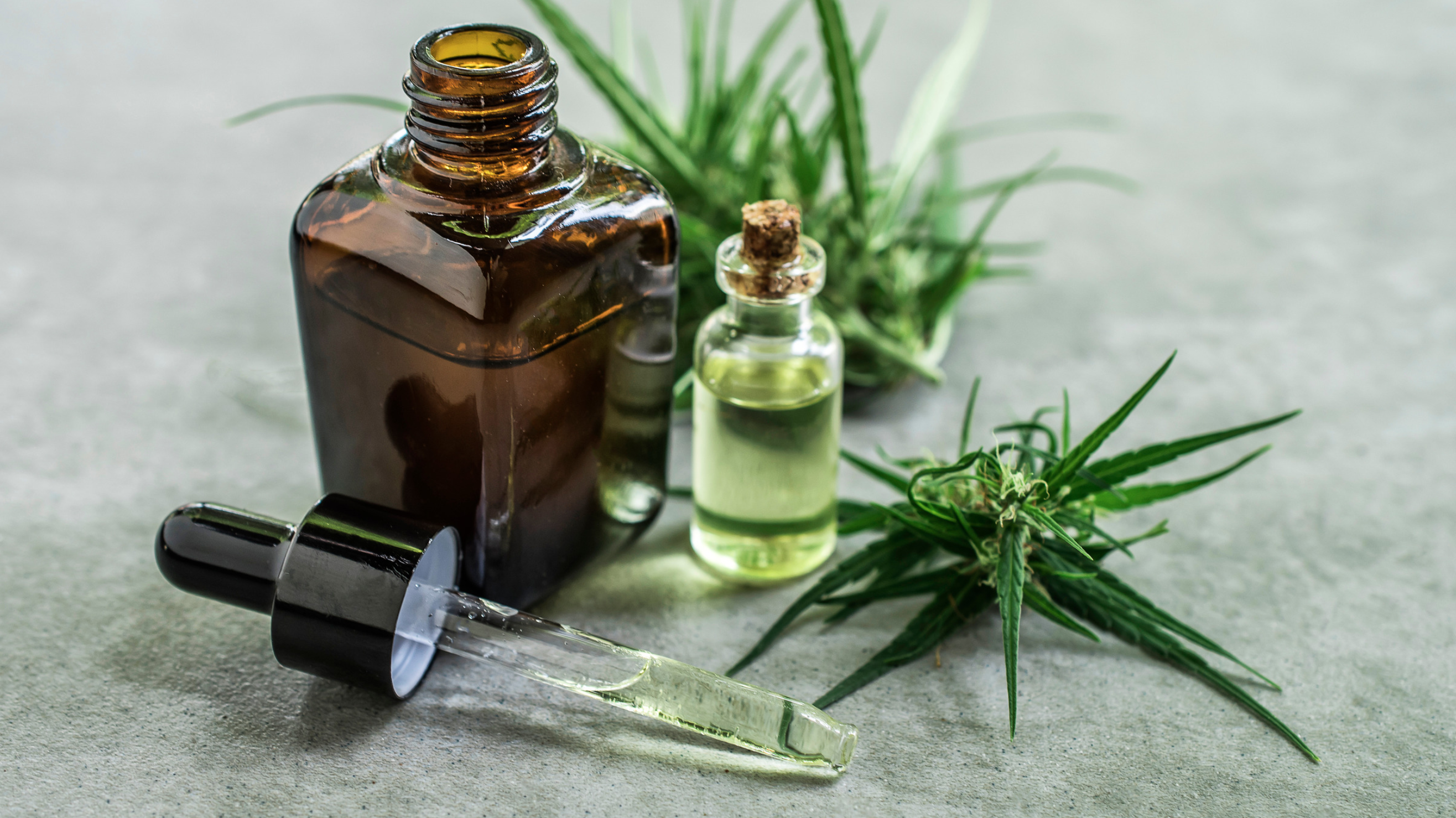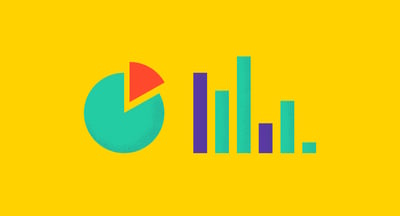Whether you’re for it or against it, it’s evident that cannabis legalization has taken hold in the political landscape.
Laws around its recreational and medical use has spread like wildfire throughout the United States, joining countries around the world in the debate. Naturally, business is booming in the industry as investors and entrepreneurs are taking full advantage of supportive legislation. Plus, the growing adaptation and demand for cannabis-derived pharmaceutical products shows promise of noticeable boost in demand worldwide.
If you’re reading this, you may be considering starting your own cannabis business, so we’re here to help you stay informed about the statistics to foresee or lessen possible roadblocks.
Although it can be easy to hypothetically throw cannabis, marijuana, and hemp in the same glass bowl, there are differences when it comes to the varied usage in terminology and purposes. People may confuse the terms cannabis, marijuana, hemp, CBD, and THC, even though there is distinction between them. Let’s dive into these terms so we know the differences before moving forward.
Note: This might be information that you are already familiar with, but it doesn’t hurt to go back to the basics. Or feel free to skip ahead with the links below.
What’s the difference between cannabis, marijuana, hemp, CBD, and THC?
- Cannabis is the technical terminology and umbrella term for the plant belonging to the family Cannabaceae, and is usually interchangeable with the word ‘marijuana’.
- Marijuana is the common term that originated from the Mexican Spanish spelling, ‘marihuana’ or ‘mariguana’ and was popularized during the 1930s anti-drug propaganda.
- Hemp is the term used for a cannabis plant that is specifically grown for its industrial use (textiles, fibers, food, etc..) and is “non-intoxicating” due to its low psychoactive compound structure.
- CBD is short for ‘cannabidiol’ and is one of the hundreds of active compounds in the cannabis plant. CBD is the essential ingredient people look for in medicinal products and does not have the psychoactive effect that THC does, although the two compounds may work better together.
- THC stands for 'tetrahydrocannabinol' and is another of the hundreds of compounds in the cannabis plant. Its the chemical responsible for the psychoactive experience of a head high that marijuana's recreational usage is known for.

Being one of the most versatile plants on Earth, cannabis has three common uses: medicinal, recreational, and industrial. A canna-businesses or investment typically falls into one of these categories.
Cannabis vs. marijuana - what's the difference?
The following definitions cover the commonly-confused, closely-related terminology.
Medicinal cannabis is widely expanding in pharmaceutical demand, for both people and their pets. The effects of CBD are currently used to treat or relieve a long list of ailments including epileptic seizures, back pain, inflammation, and so much more. It's also increasing in popularity among clinical studies to treat mental illness and addictions.
Recreational marijuana is used to purposely change the user’s state of consciousness and is one of the more common, yet notorious, uses that people associate with the cannabis plant. It can either be smoked or made into a concentrate, which involves refining the plant into a more potent product. Edibles and the surplus of cannabis-infused products are the fastest-growing sector in the cannabis market.

Industrial hemp is one of the oldest cultivated crops that exists. Its has been used for centuries of our history around the globe for a variety of reasons. Hemp can be utilized to produce paper, clothing, textiles, insulation, food, biodegradable plastics, biofuel, and an abundance of other products
With the endless potential that cannabis carries, having an idea of the current statistics and trends can be help you saddle up for a successful venture. Take a look at what the latest marijuana statistics have to say about its future.
Note: The following statistics are categorized by the terms cannabis, marijuana, hemp, and CBD to keep them organized should you need to find specific facts for one.
Cannabis statistics
- In 2018, the U.S. had 9 billion sales of legal cannabis (Statista, 2018).
- As of 2017, there were a total of 28,000 businesses in the cannabis industry (Statista, 2018).
- By 2020, it is projected that a total of 283,422 jobs will be created as a result of the legal cannabis industry (Statista, 2018).
- Total cannabidiol sales in the U.S. were at $500 million in 2018 (Statista, 2018).
- The most common use of cannabis among U.S. adults is for relaxation. Stress relief and enjoying social experiences are second and third place at 40% (Statista, 2018).
- 85% of legal cannabis consumption is used for the treatment of pain (Statista, 2018).
- The illegal cannabis market in the U.S. is estimated to be worth more than $45 billion a year (Cannabis Investment Report, 2018).
- More than 85% of publicly traded cannabis-related companies have an annual revenue of less than $5 million (Cannabis Investment Report, 2018).
- Less than 5% of publicly traded cannabis-related companies have an annual revenue greater than $25 million (Cannabis Investment Report, 2018).
- Cannabis jobs pay higher than the U.S. median salary (Glassdoor, 2019).
- Wall Street analysts forecast cannabis will grow to $80 billion by 2030 (ETF Trends, 2019).
- Since the legalization of recreational cannabis, 34% of consumers who live in legalized states report a decrease in alcohol consumption (Mintel, 2018).
- 51% of alcohol consumers also use cannabis at the same time (Mintel, 2018).
- 33% of consumers that live in states where recreational use is legal use cannabis to enhance experiences (The Recreational Cannabis User, 2018).
- 40% of cannabis users partake in the product daily (The Recreational Cannabis User, 2018).
- 55% of Americans think cannabis should be legalized, regulated, and taxed like cigarettes and alcohol (Statista, 2018).
- The legal cannabis market is projected to hit $23.4 billion by 2022 (Forbes, 2018).
- Nearly 90% of operating dispensaries, cultivators, and infused product companies report that they are profitable (American Cannabis Company, 2018).
- North America is the fourth largest cannabis consumer market, (Benzinga, 2019).
- 12% of cannabis users say CBD-only products reduce the need for marijuana/cannabis (Mintel, 2018).
- 15% of consumers in legal recreational cannabis states use CBD-only products (Mintel, 2018).
- 74% of consumers are likely to have prior experience with recreational cannabis (Deloitte, 2018).
- 63% of current and potential cannabis users are more likely to purchase their products at physical retail locations (Deloitte, 2018).
- One-third of recreational cannabis users indicate an interest in purchasing their products online (Deloitte, 2018).
- Canada’s overall spend on legal cannabis is expected to rise up to 58% in 2019 (Deloitte, 2018).
- In the cannabis industry, women hold 36% of executive positions, as opposed to 15% in other industries (Fashion Magazine, 2019).
- It takes two to three months for a cannabis plant to grow to adulthood (Prevention*, 2019).
- The distinct cannabis smell is given by an oil called terpenes, which is secreted from the glands of the plant (Prevention*, 2019).
- The worldwide market for Terpenes is expected to grow by roughly 6.3% over the next five years (Marketwatch, 2019).
- Cannabinoids work by binding to receptors in your brain and body, which is what gives the healing and medicinal properties (Prevention*, 2019).
- The cannabis industry employs five times more Americans than the coal industry (Business Insider, 2019).
Marijuana statistics
- As of writing, recreational marijuana use is legal in 10 states. Medical use is legal in 34. (DISA, 2019).
- 92% of medical marijuana patients say it works (The Washington Post, 2014).
- 12% of U.S. adults are reported to use marijuana on a daily basis and 11% use it on a weekly basis (Statista, 2017).
- The most popular form of marijuana consumption is flower at 74%. Solid edibles come in second at 44% (Statista, 2017).
- 59% of the U.S. population lives in a state where marijuana has been legalized (Kindland, 2017).
- The average consumer spends $645 per year on marijuana products (Kindland, 2017).
- 13% of Americans identify as “current users” (FlowHub, 2019).
- 48% of men have tried marijuana while just 34% of women have tried it (Gallup, 2016).
- Marijuana dispensary prices are more expensive than street prices in all states that it is legal (Statista, 2016).
- In 2018, investors for $10 billion into the North American marijuana market (FlowHub, 2019).
- Retail sales for recreational marijuana were at $4.4 billion in 2018 and is expected to reach $7.5 billion by 2020 (Statista, 2018).
- 34% of marijuana consumers reduced their alcohol consumption since the legalization of cannabis (Mintel, 2018).
- In a 15 year period, Americans’ choice of keeping marijuana illegal decreased by 32% (Statista, 2018).
- States spend over $3 billion every year to enforce marijuana laws (ACLU).
- 41% of consumers use marijuana with other people (The Washington Post, 2017).
- 70% say marijuana is less risky than alcohol (The Washington Post, 2017).
- 76% say marijuana is less risky than tobacco (The Washington Post, 2017).
- 42% of respondents stopped taking pharmaceutical drugs due to the medical use of cannabis (Medical Express, 2019).
- 18% of American consumers who smoke marijuana are between 18-29 years old (FitSmallBusiness, 2019).
- The startup cost for a regulated dispensary is approximately $775,000 (Statista, 2017).
- Legal marijuana trade grew by 37% in 2017 and was worth $9.5 billion (Forbes, 2018).
- The average annual revenue for regulated dispensaries is $3 million (Statista, 2017).
- The average spend at a marijuana retailer is $25-$50 per trip (Forbes, 2016).
- 35 million Americans are regular users of marijuana (Sacramento Bee, 2017).
- Medical marijuana users buy more frequently and spend more than recreational users (Green Entrepreneur, 2017).
Hemp statistics
- Evidence of hemp fabric dates back to 8,000 years ago in Turkey (National Hemp Association).
- Hemp products are now legal in the U.S. (National Hemp Association).
- The U.S. had $820 million sales in hemp-based products in 2017 (Hemp Business Journal, 2017).
- The Americas was the leading region for global hemp-based foods in 2017 with a market share of 57% (Business Wire, 2018).
- Hemp is one of the most versatile of plants, with an estimated 50,000 uses across a wide spectrum of industries (Hemp Business Journal).
- Hemp-derived CBD is the most consumed product in the U.S. with $390 million is sales in 2018 (Statista, 2018).
- The global market for hemp consists of over 25,000 products in nine submarkets: agriculture, textiles, recycling, automotive, furniture, food & beverage, paper, construction materials, and personal care (Statista, 2018).
- One acre of hemp produces as much fiber as 2-3 acres of cotton (Hemp Farm, 2017).
- Hemp-based products in the U.S. were over $688 million in sales value in 2016 (Penn State University, 2018).
- Total retail value of hemp products in the U.S. was at $820 million in 2017 (Agricultural Marketing Resource Center, 2018).
- China’s Province of Heilongjian cultivates nearly 90% of textile hemp used around the world (Benzinga, 2019).
- By generation, 11% of Gen Z respondents said that they occasionally or regularly used CBD or hemp oil products (Statista, 2019).
- In 2018, the sale of hemp-based products in the U.S. reached $1.1 billion (Statista, 2019).
- Globally, hemp sales amounted to $3.7 billion in 2018 (Statista, 2019).
- Hemp was consumed as a healing plant as early as the 5th and 6th centuries in Russia, and often used in teas and soups (Prevention*, 2019).
- Hemp is known to have over 50,000 different uses and is the strongest natural fiber in the world (Medium, 2018).
- If a plant has less than 0.3% THC, it is an international standard definition that it be considered hemp (Prevention*, 2019).
CBD statistics
- Cannabis industry analysts predict that CBD will soon be a $22 billion industry (Prevention*, 2019).
- CBD is just one of a hundred compounds found in the oils of the cannabis plant (Prevention*, 2019).
- 62% of respondents say that they take CBD for a specific medical condition (Prevention, 2019).
- Due to varying regulations based on the state you live in, there is a 75% chance that a CBD product you buy online will be mislabeled (Prevention*, 2019).
- According to the American Cannabis Nurses’ Association, most patients are curious about CBD for treating pain, sleep issues, anxiety, or depression (Prevention*, 2019).
- There are a variety of ways to consume CBD, including vaping, ingestibles, sublingual, and topical (Prevention*, 2019).
- 59% of THC-based companies say that the CBD-focused industry is not a threat to their business (MJBizDaily, 2018).
CBD and pets
- Cannabis oil can be used to treat and relieve pets of many health conditions such as nausea, stress, anxiety, arthritis, back pain, GI issues, and more (PetMD, 2019).
- 89% of dogs that received CBD in a clinical trial had reductions in the frequency of seizures (Prevention*, 2019).
- Researchers at Cornell University College of Veterinary Medicine found that 80% of dogs experiencing pain from osteoarthritis had significant improvement in pain levels and quality of life (Prevention*, 2019).
- The most popular form of consumption is edibles, such as dog treats, but it can also be mixed in with food and supplements (Prevention*, 2019).
- 29% of vets reported that they are asked about cannabis products for pets on a weekly basis. (Prevention*, 2019).
- 56% of vets reported that they had clinical experience with CBD products in dogs (Prevention*, 2019).
- 56% of vets stated that CBD products were somewhat helpful for pets with chronic pain (Prevention*, 2019).
- 66% of vets said that they found CBD to be somewhat helpful for pets with anxiety (Prevention*, 2019).
- 80% of vets reported that there were no side effects from pets taking CBD (Prevention*, 2019).
- CBD products for pets may grow into a $1.6 billion industry by 2020 (CBNBC, 2019).
- CBD and hemp products spiked 300% on pet insurance claims between 2017 and 2018 (Veterinary Practice News, 2019)
Final thoughts
The current marijuana statistics and trends not only demonstrate cannabis as one of the most versatile plants on Earth, but its enormous economic influence. Yet, each branch of the cannabis industry carries nuances that affect users, investors, cultivators, and business owners alike.
With increasing popularity in societal and political acceptance, infinite opportunities present themselves to those interested in going green. At this time, a cannabis market venture might be lucrative for anyone interested in heightening their business senses.
*Note: these sources were taken from the Prevention Special Report CBD 101 issue.
Do you have experience using cannabis retail POS software?





 by Maddie Rehayem
by Maddie Rehayem
 by Meghan Treptow
by Meghan Treptow
 by Lauren Pope
by Lauren Pope
 by Maddie Rehayem
by Maddie Rehayem
 by Meghan Treptow
by Meghan Treptow



